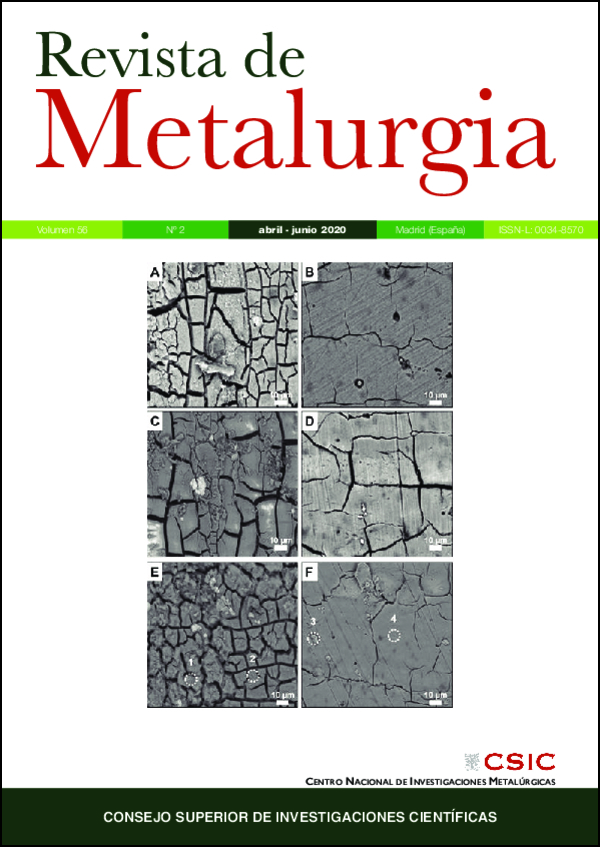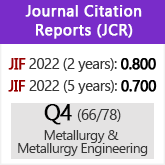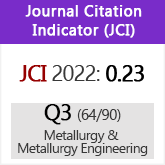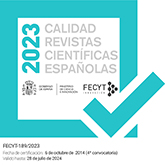Phase evolution of Ba1-xEuxTi1-x/4O3 during the sintering process in air with high temperature in situ X-ray diffraction
DOI:
https://doi.org/10.3989/revmetalm.167Keywords:
BaTiO3, Eu3 , High temperature in situ X-Ray Diffraction, SinteringAbstract
The phase evolution of Ba1-xEuxTi1-x/4O3 during the sintering process (heating and cooling) in the air with x = 0.0054, 0.0384, 0.1920, and 0.2689 mol% Eu2O3 was investigated by high temperature in situ X-ray diffraction in the range of temperature between 30 and 1200 °C. The samples were prepared mixing BaCO3, TiO2 and Eu2O3 powders using the solid-state method. The results obtained for the samples with x ≥ 0.2689 mol% Eu2O3 showed the cubic phase BaTiO3 doped with Eu3+ at 900 °C. Below 500 °C the tetragonal ferroelectric phase BaTiO3 doped with Eu3+ was detected. The secondary phase Ba2TiO4 was identified in the samples when heated to 1100°C with x = 0.0054, 0.0384 and 0.2689 mol% Eu2O3 and at 1200 °C for x = 0.1920 mol% Eu2O3. The secondary phases Eu2Ti2O7 and Eu2TiO5 were identified during cooling in the temperature range of 1200 °C to room temperature for the sample with x = 0.1920 and 0.2689 mol% Eu2O3. The results of high-resolution scanning electron microscope (HRSEM) showed a wide grain-size distribution, a partially homogeneous microstructure and higher amounts of inter-granular porosity as well as a uniform incorporation and distribution of Ti, Ba and Eu in each sample.
Downloads
References
Amin, A., Spears, M., Kulwicki, B. (1983). Reaction of Anatase and Rutile with Barium Carbonate. J. Am. Ceram. Soc. 66 (10), 733-738. https://doi.org/10.1111/j.1151-2916.1983.tb10540.x
Antao, S.M., Hassan, I. (2007). BaCO3: high-temperature crystal structures and the Pmcn→R3m phase transition at 811°C. Phys. Chem. Minerals 34, 573-580.
https://doi.org/10.1007/s00269-007-0172-8
Barrientos Hernández, F.R., Lira Hernández, I.A., Gómez Yáñez, C., Arenas Flores, A., Cabrera Sierra, R., Pérez Labra, M. (2014). Structural evolution of Ba8Ti3Nb4O24 from BaTiO3 using a series of Ba(Ti1−5xNb4x)O3 solid solutions. J. Alloys Compd. 583, 587-592. https://doi.org/10.1016/j.jallcom.2013.09.016
Beauger, A., Mutin, J., Niepce, J. (1983a) Synthesis reaction of metatitanate BaTiO3. Part 1. J. Mater. Sci. 18, 3041-3046. https://doi.org/10.1007/BF00700786
Beauger, A., Mutin, J., Niepce, J. (1983b). Synthesis reaction of metatitanate BaTiO3. Part 2 Study of solid-solid reaction interfaces. J. Mater. Sci. 18, 3543-3550. https://doi.org/10.1007/BF00540726
Beauger, A., Mutin, J., Niepce, J. (1984). Role and behaviour of orthotitanate Ba2TiO4 during the processing of BaTiO3 based ferroelectric ceramics. J. Mater. Sci. 19, 195-210. https://doi.org/10.1007/BF02403126
Belous, A.G., V'yunov, O.I., Khomenko, B.S. (1998). Microstructure and semiconducting properties of barium titanate containing heterovalent substituents on the titanium site. Inorganic Materials 34 (6), 597-601.
Brzozowski, E., Castro, M.S. (2003). Lowering the synthesis temperature of high-purity BaTiO3 powders by modifications in the processing conditions. Thermochim. Acta. 398 (1-2), 123-129. https://doi.org/10.1016/S0040-6031(02)00353-2
Buessem, W.R., Kahn, M. (1971). Efects of grain growth on the distribution of Nb in BaTiO3 ceramics. J. Am. Ceram. Soc. 54 (9), 458-461. https://doi.org/10.1111/j.1151-2916.1971.tb12385.x
Chan, H.M., Harmer, M.R., Smyth, D.M.L. (1986). Compensating Defects in Highly Donor-Doped BaTiO3. J. Am. Ceram. Soc. 69 (6), 507-510. https://doi.org/10.1111/j.1151-2916.1986.tb07453.x
Chung, D.D.L., DeHaven, P.W., Arnold, H., Ghosh, D. (1994). X-ray diffraction at elevated temperatures: a method for in situ process analysis. J. Appl. Cryst. 27, 441-442. https://doi.org/10.1107/S0021889893013809
Dunbar, T.D., Warren, W.L., Tuttle, B.A., Randall, C.A., Tsur, Y. (2004). Electro paramagnetic resonance investigations of lanthanide-doped barium titanate: Dopant site occupancy. J. Phys. Chem. B 108, 908-917. https://doi.org/10.1021/jp036542v
Glerup, M., Nielsen, O.F., Poulsen, F.W. (2001). The Structural Transformation from the Pyrochlore Structure, A2B2O7, to the Fluorite Structure, AO2, Studied by Raman Spectroscopy and Defect Chemistry Modeling. J. Solid State Chem. 160 (1), 25-32. https://doi.org/10.1006/jssc.2000.9142
Hernández Lara, J.P., Pérez Labra, M., Barrientos Hernández, F.R., Romero Serrano, J.A., Ávila Dávila, E.O., Thangarasu, P., Hernández Ramirez, A. (2017). Structural Evolution and Electrical Properties of BaTiO3 Doped with Gd3+. Mat. Res. 20 (2), 538-542. https://doi.org/10.1590/1980-5373-mr-2016-0606
Hilton, A.D., Frost, R. (1992). Recent Developments in the Manufacture of Barium Titanate Powders. Key Eng. Mater. 66-67, 145-184. https://doi.org/10.4028/www.scientific.net/KEM.66-67.145
Lefevre, G., Herfurth, A., Kohlmann, H., Sayede, A., Wylezich, T., Welinski, S., P. Vaz Duarte., Parker, S.F., Blach, J.F., Goldner, P., Kunkel, N. (2018). Electron-phonon coupling in luminescent europium doped hydride perovskites studied by luminescence spectroscopy, inelastic neutron scattering, and first-principle calculations. J. Phys. Chem. C 122, 10501-10509. https://doi.org/10.1021/acs.jpcc.8b01011
Mitic, V.V., Nikolic, Z.S., Pavlovic, V.B., Paunovic, V., MilJovic, M., Jordovic, B., Zivkovic, L. (2010). Influence of rare-earth dopants on barium titanate ceramics microstructure and corresponding electrical properties. J. Am. Ceram. Soc. 93 (1), 132-137. https://doi.org/10.1111/j.1551-2916.2009.03309.x
Moulson, A.J., Herbert, J.M. (1990). Electroceramics: Materials, Properties, Applications. Chapman & Hall, London.
Mutin, J.C., Niepce, J.C. (1984). About stoichiometry of polycrystalline BaTiO3 synthesized by solid-solid reaction. J. Mater. Sci. Lett. 3, 591-592. https://doi.org/10.1007/BF00719620
O'Bryan Jr., H., Thomson Jr., J. (1974). Phase Equilibria in the TiO2-Rich Region of the System BaO-TiO2. J. Am. Ceram. Soc. 57 (12), 522-526. https://doi.org/10.1111/j.1151-2916.1974.tb10801.x
Pavlovic, V.P., Stojanovic, B.D., Pavlovic, V.B., Marinkovic- Stanojevic, Z., Živković, Lj., Ristic, M.M. (2008). Synthesis of BaTiO3 from a Mechanically Activated BaCO3-TiO2 System. Sci Sinter. 40, 21-26. https://doi.org/10.2298/SOS0801021P
Sahmi, A., Laib, R., Omeiri, S., Bensadok, K., Trari, M. (2019). Photoelectrochemical properties of Ba2TiO4 prepared by nitrate route. Application to electro-photocatalysis of phenobarbital mineralization by solar light. J. Photoch. Photobio. A. 372, 29-34. https://doi.org/10.1016/j.jphotochem.2018.12.003
Syamala, K.V., Panneerselvam, G., Subramanian, G.G.S., Antony, M.P. (2008). Synthesis, characterization and thermal expansion studies on europium titanate (Eu2TiO5). Thermochim. Acta 475 (1-2), 76-79. https://doi.org/10.1016/j.tca.2008.05.008
Takada, K., Chang, E., Smyth, D.M. (1987). Rare earth additions to BaTiO3. Advan. Ceram. 19, 147-152.
Templeton, L., Pask, J. (1959). Formation of BaTiO3 from BaCO3 and TiO2 in Air and in CO2. J. Am. Ceram. Soc. 42, 212-216. https://doi.org/10.1111/j.1151-2916.1959.tb15455.x
Veith, M., Mathur, S., Lecerf, N., Huch, V., Decker, T., Beck, H., Wiser, W., Haberkorn, R. (2000). Sol-Gel Synthesis of Nano-Scaled BaTiO3, BaZrO3 and BaTi0.5Zr0.5O3 Oxides via Single-Source Alkoxide Precursors and Semi-Alkoxide Routes. J. Sol-Gel Sci. Technol. 17, 145-158. https://doi.org/10.1023/A:1008795419020
Vijatovic', M.M., Stojanovic', B.D., Bobic', J.D., Ramoska, T., Bowen, P. (2010). Properties of lanthanum doped BaTiO3 produced from nanopowders. Ceram. Int. 36 (6), 1817-1824. https://doi.org/10.1016/j.ceramint.2010.03.010
Viviani, M., Buscaglia, M.T., Nanni, P., Parodi, R., Gemme, G., Dacca, A. (1999). XPS investigation of surface properties of Ba(1-x)SrxTiO3 powders prepared by low temperature aqueous synthesis. J. Eur. Ceram. Soc. 19 (6-7), 1047-1051. https://doi.org/10.1016/S0955-2219(98)00371-9
Zhang, Y., Hao, J. (2013). Color-tunable upconversion luminescence of Yb3+, Er3+, and Tm3+ tri-doped ferroelectric BaTiO3 materials. J. Appl. Phys. 113 (18), 184112.
Zhi, J., Chen, A., Zhi, Y., Vilarinho, P.M., Baptista, J.L. (1999). Incorporation of yttrium in barium titanate ceramics. J. Am. Ceram. Soc. 82 (5), 1345-1348. https://doi.org/10.1111/j.1151-2916.1999.tb01921.x
Published
How to Cite
Issue
Section
License
Copyright (c) 2020 Consejo Superior de Investigaciones Científicas (CSIC)

This work is licensed under a Creative Commons Attribution 4.0 International License.
© CSIC. Manuscripts published in both the printed and online versions of this Journal are the property of Consejo Superior de Investigaciones Científicas, and quoting this source is a requirement for any partial or full reproduction.All contents of this electronic edition, except where otherwise noted, are distributed under a “Creative Commons Attribution 4.0 International” (CC BY 4.0) License. You may read here the basic information and the legal text of the license. The indication of the CC BY 4.0 License must be expressly stated in this way when necessary.
Self-archiving in repositories, personal webpages or similar, of any version other than the published by the Editor, is not allowed.


















